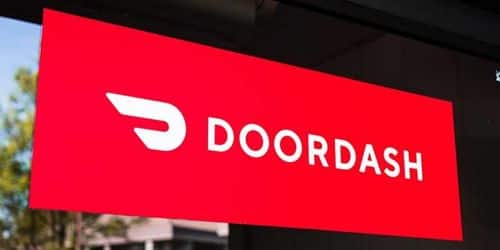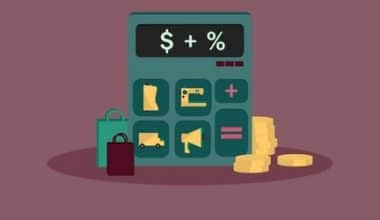DoorDash is an online food delivery service that works with local eateries to deliver meals to people in their neighborhoods. Contractual drivers (referred to as Dashers) make deliveries on an as-needed basis.
DoorDash generates money through commissions, delivery and service fees, a white-label logistics solution, a premium subscription plan, advertising, cash advance fees, and a catering service it offers to other businesses.
What Does DoorDash Do?
Andy Fang, Tony Xu, Evan Moore, and Stanley Tang, Stanford alumni who founded the company in 2013, aimed to disrupt and innovate the food delivery sector. At its inception, food delivery services merely listed restaurants, leaving the eateries to deliver orders themselves.
The company began as “PaloAltoDelivery.com,” with the launch serving as a platform test. After receiving hundreds of orders in the first few weeks of operation, the founders decided to formalize the operation, which resulted in the creation of DoorDash.
DoorDash had a $600 million valuation two years after its creation and was available in 18 locations across the United States by 2015.
How Does DoorDash Work?
DoorDash is a food delivery service that allows clients to purchase food from local restaurants and deliver it to their door. Users place orders via the site’s web platform, which is available for Android and iOS smartphones.
DoorDash does not prepare meals; instead, it collects food from a partner restaurant and delivers it to the customer.
The company has an army of “Dashers” who deliver customer orders. DoorDash recruits Dashers on a contract basis, reducing the need for full-time staff. As a result, the Dasher does not earn a wage. They only make money from the orders they make for the site.
DoorDash compensates its Dashers in various ways, including base compensation for deliveries, promotions for working during peak hours, and awards for completing challenges, such as making a particular number of deliveries in a given time frame.
The back office team of DoorDash manages the marketplace and the payment procedure. Customers pay DoorDash directly when they order, and restaurants receive their money back from the platform after deducting delivery and service fees.
DoorDash delivers meals, and clients can order from convenience stores and other marketplaces such as Walgreens.
How Does DoorDash Make Money?
DoorDash generates money through commissions, delivery and service fees, a white-label logistics solution, a premium subscription plan, advertising, cash advance fees, and a catering service it offers to other businesses.
DoorDash’s business concept is based on a three-sided marketplace. The company successfully serves hungry customers, eateries, and its drivers.
The key to developing a thriving marketplace is to provide liquidity, which means that clients can order at any time from a range of restaurants while waiting times are kept to a minimum.
As a result, DoorDash must ensure that its drivers and restaurant partners are motivated to remain on the platform to meet demand.
Due to growing fuel costs, DoorDash established a Gas Rewards program in March 2022 to help drivers offset rising gas prices.
Similarly, it now provides various related services to restaurants, such as cash advances and white-label delivery services.
Customers and restaurants also benefit from discoverability elements such as ratings, written reviews, “most liked” tags, etc.
This contributes to DoorDash’s goal of becoming the de facto last-mile logistics platform. While it may have begun with restaurant food, it is not unreasonable to expect the company to expand into all types of logistics services eventually.
So, without further ado, let’s examine the different ways DoorDash makes money.
#1. Commissions
DoorDash charges restaurants a variable percentage fee for each order placed through its platform. This variable sum is automatically deducted every time an order is placed.
DoorDash will implement a tiered commission system in April 2021. Restaurants pay a 15 percent (Basic), 25 percent (Plus), or 30 percent (Premier) charge under the new arrangement.
Depending on which plan a restaurant chooses, different perks are available. For example, Plus provides eateries with increased visibility on the app and access to DashPass users.
Similarly, when users request convenience items, booze, and so on, DoorDash charges a commission.
It will open DashMart in August 2020, allowing customers to order practically any commodity, from toilet paper to shampoo. DashMart’s partners include 7-Eleven, CVS, Walgreens, and Wawa.
Furthermore, the company is experimenting with several other revenue-generating services. For example, in late 2021, it established an ultra-fast delivery service and collaborated with other companies to manage package returns.
Almost all of DoorDash’s rivals make most of their revenue through commissions. ChowNow is the one exception, having chosen to monetize eateries through subscription fees.
#2. Fees for Delivery and Service
In addition to the restaurant commission, DoorDash makes money by charging clients for delivery and other services.
Depending on the distance and current demand, delivery rates often range between $6 and $8. Delivery fees are used to compensate drivers, but the corporation does not reveal how much money ends in the drivers’ pockets.
Service costs are computed as a percentage of the subtotal of the order. They can cover a range of costs with the service fees, such as technological development, marketing, and payment processing.
#3. DashPass
DashPass by DoorDash is a monthly subscription service that saves users money on delivery and service expenses.
Customers will not have to pay delivery fees for items over $12 if they pay a flat monthly price of $9.99. In addition, service costs are charged at a lower rate.
Notably, not all restaurants participate in the DashPass network. Customers can cancel anytime, just like with other subscription services like Netflix.
Customers who subscribe to DashPass will save an average of $4-5 per order, according to
#4. DoorDash.
Customers who regularly use the DoorDash app for dinner deliveries will benefit from the subscription service.
Customers can benefit from subscriptions in a variety of ways. To make with, it boosts their inclination to order from DoorDash to compensate for the money they pay. Money spent on DoorDash is therefore not spent on a competitive service.
Secondly, DoorDash can instantly invest funds in other areas. Sam’s Club and Amazon both popularized this method (via Prime).
Finally, clients are likely to order more than they would have without the subscription, allowing DoorDash to cross-sell them into other services, such as same-day grocery delivery.
Drive Drive is a white-label logistics business that enables other restaurants to use DoorDash’s driver fleet.
It is intended for merchants who currently generate demand through their own platform but cannot always meet that need. Customers such as Denny’s and Wing Stop fall into this category.
DoorDash costs between $6.99 and $10.99 for each delivery. Unlike restaurant partners, drive customers are not charged a commission.
There are no restrictions on how DoorDash might commercialize its while-label service. For example, during peak periods like Christmas, it may lease its drivers to other platforms such as Amazon.
#4. DoorDash For Work
Companies can use DoorDash for Work to subscribe their staff to DashPass. Due to the epidemic, the service is intended for employees compelled to work from home.
DoorDash earns money via subscriptions and the fees it charges for the orders it handles.
These businesses can then utilize the firm’s catering services. DoorDash most likely collaborates with local caterers and takes a cut of the bill.
#5. Advertising
Restaurants can boost their exposure on the platform by purchasing different promotion packages.
They can, for example, use Sponsored Listings, which appear naturally in the user’s app feed.
They can also run campaigns that give clients discounts, free things, or no shipping expenses.
Unlike other platforms’ adverts, Sponsored Listings are paid per order rather than each click. That means eateries only get paid if the customer buys something.
Similarly, restaurants pay DoorDash a marketing fee of $0.99 for each successful promotion they run.
#6. Cash Advances
DoorDash began offering to finance to eateries on its marketplace that want loans to expand their operations in February 2022.
The service, dubbed DoorDash Capital, allows eateries to apply for funding to fund business operations such as purchasing equipment and paying rent.
It should be highlighted that this is not a loan but rather a cash advance. That is, DoorDash charges a one-time fee rather than monthly interest payments.
Restaurants can repay cash advances by selling on the platform. Repayment periods are typically 6 to 9 months long.
Other Businesses
DoorDash owns various additional businesses that generate revenue for the company. Caviar, Scotty Labs, and Chowbotics are among them. Caviar, like DoorDash, is a high-end delivery service aimed at upmarket eateries. Chowbotics sells robots that make customized bowls of cereal, yogurt, and salad. Scotty Labs is developing self-driving automobiles.
What Distinguishes DoorDash’s Business Model?
Through its platform, DoorDash’s business model is based on meeting the needs of three stakeholders. Merchants, consumers, and Dashers are examples of stakeholders. The platform’s success can be ascribed to its marketplace ecology, which benefits all stakeholders and scalability.
#1. Merchants:
Through its marketplace, DoorDash provides merchants with a wide range of services that help them handle mission-critical concerns such as client acquisition, delivery, insights and analytics, merchandising, payment processing, and customer support.
Merchants can also use the marketplace to develop an online presence and grow their reach. Connecting merchants with millions of consumers generate considerable demand for them. Merchants can meet this demand through delivery provided by DoorDash’s local logistics infrastructure or consumer in-person pickup. As of December 2020, the platform had approximately 450,000 vendors.
#2. Consumers:
DoorDash allows customers to order from the most outstanding restaurants in their neighborhoods with the press of a button and have their purchases delivered or picked up at the store. On DoorDash, over 20 million people explore, interact with, and purchase goods from merchants.
#3. Dashers:
Dashers are DoorDash’s local drivers. More than a million dashers connect merchants and consumers. These dashers can determine their work schedules and make delivery selections. DoorDash provides chances for Dashers who want a quick and flexible approach to earning money and achieving their goals.
The logistics platform at DoorDash benefits from three significant virtuous cycles that result in a win-win situation for all major stakeholders:
#4. Network Effects:
This is a circular relationship between consumers and merchants. DoorDash’s technology-enabled service stack platform draws a diverse range of merchants, expanding the marketplace’s offering. Customers are more engaged due to such selection, which leads to increased merchant sales. More sales as a value proposition attract more merchants, who attract more customers.
#5. Scale economies:
This is a cycle between consumers and dashers. As more customers sign up, DoorDash will benefit from increased order volume. This implies more cash for local businesses and more chances for Dashers to work and earn more money. This, in turn, attracts Dashers, allowing for faster and more efficient order fulfillment for customers.
This is a cyclical relationship between merchants and dashers. DoorDash benefits from greater brand recognition and good brand affinity as its network of three critical stakeholders increases. In-network growth benefits merchants and dashers because more merchants mean more selection, customer engagement, and earning opportunities for dashers. More dashers suggest that businesses have access to quick and cost-effective logistics solutions.
DoorDash’s business concept did a few things right:
- Suburban Focus: It is challenging to deliver in cities. Customers want to pay less, while drivers want more pay; traffic is awful, and parking is difficult. Suburbs have more robust fundamentals and more people.
- Prioritize quality over speed: A food delivery company might compete on speed, affordability, selection, or quality. Uber Eats focuses on delivering in less than 30 minutes and at a low cost. DoorDash understood it couldn’t compete on price with Uber. As a result, DoorDash distinguished itself in terms of selection and quality.
What are the Threats and Possibilities in the Doordash Business Model?
There is no business model that is immune to attacks. The DoorDash business model is no exception. It is under attack from various sources, including merchants, consumers, and Dashers.
Let me go over each threat in greater detail:
- Merchant: As seen in the unit economics example above, a merchant receives just $20.10 for an order; it would have earned $22.40, resulting in a loss of over 9% in sales. It appears excessive until a rise in sales compensates for the revenue loss.
- Customer: As illustrated in the unit economics example above, the cost of a customer’s order increased by over 40%. How many diners do you believe exist who are prepared to pay a 30-40% premium to have meals delivered to their door? Not a lot. Furthermore, as Covid continues to fall and the economy continues to improve, people should begin to return to sit-down eateries. This impacts DoorDash, one of the significant benefactors of the pandemic, with sales more than tripling to $2.9 billion last year. This may be seen in the stock price of DoorDash, which jumped 86% on its first day (9th December 2020) but has since fallen. The stock dropped 40% in November of this year.
- Dasher: As demonstrated in the example, a dasher received only $7.9 per hour, which is somewhat higher than the national minimum wage but frequently less than what is mandated by the states in which DoorDash operates.
An analysis of over 200 samples of pay data provided by DoorDash workers across the country by #Payup (a labor movement) reveals that DoorDash pays the average worker an astonishingly low $1.45/hour, even after accounting for mileage costs and additional payroll taxes borne by independent contractors. After deducting these basic expenses, over a third of jobs pay less than $0 per hour. Only 11% of employees pay more than the federal minimum wage of $7.25 per hour after expenses, and only 2% pay more than $15 plus expenses.
Read Also: HOW UBER EATS MAKES MONEY: All You Need To Know
Let us now consider the possibilities:
- DoorDash announced a partnership with regional and national convenience stores across the United States, including 7-Eleven, Wawa, Casey’s General Store, and CircleK, in April ’20, to provide on-demand essential household products straight to your doorstep via a no-contact drop-off option.
- DoorDash announced the introduction of DashMart, a chain of virtual convenience stores that will sell snacks, groceries, and other food-related products from partner restaurants, in August 2020. These stores do not have physical locations. Instead, they live exclusively on the DoorDash app, similar to a ghost kitchen if it were a CVS or 7-Eleven.
- DoorDash introduced alcohol to its marketplace in 20 states in September 2021, the District of Columbia, Canada, and Australia. According to the company’s news release, users in select areas where legal can use the DoorDash app’s Alcohol tab to explore and safely order from an extensive range of drinks from restaurants, grocery stores, local businesses, and convenience stores.
- DoorDash launched ultra-fast supermarket deliveries in 10-15 minutes in December ’21, beginning with DashMart in New York City. DashMart, with over 2,000 items, would provide a diverse selection of fresh and frozen supermarket essentials, snacks, household goods, and local products to meet any last-minute shopping needs. DoorDash is entering the booming Q-commerce business to deliver quality but speed.
As we have seen, the possibilities are limitless. DoorDash is evolving into the Amazon of services. A company that began as a restaurant service now delivers groceries, wine, flowers, and pet supplies. However, given its risks, it will be intriguing to see how the entire space develops. Perhaps a new player will emerge to cause havoc.
Similar firms to DoorDash Caviar’s primary competitors include Uber Eats, Postmates, and Caviar.
Because their services are substantially similar, they may regard themselves as distinct businesses fighting for the same market share.
Conclusion
DoorDash is a successful start-up that makes money through on-demand delivery and the gig economy. Revenue is generated through delivery and service fees, commissions, subscriptions, and catering. Their business model is based on classifying drivers as independent contractors, which could be jeopardized by future labor legislation.
- DOORDASH LOGO: The Evolution Of The Brand’s Identity
- RESTAURANT MANAGEMENT SYSTEM: Guide to Effective Restaurant Management
- RESTAURANT MARKETING: What You Should Know and Strategies
- OPENING A RESTAURANT: Steps, Cost, and Guide
- THE BEST EMAIL MARKETING SERVICES FOR RESTAURANTS in 2022 (Updated)






